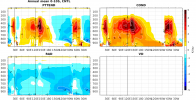Hi,
I am looking at the various physics tendency terms in CESM2.1.3, a basic F2000CLIMO control simulation. I found that the DTV and TTGW terms are about four orders of magnitude weaker than DTCOND, QRL and QRS even near the surface where they all should be comparable based on reanalysis products. In CESM, I derived DTV+TTGW from PTTEND-DTCOND-QRS-QRL (since I did not save them in history files).
As an example, below are two figures showing a zonal-vertical cross section averaged 0N-10S in my f2000climo control simulation (top 4 panels, vertical pressure coordinate) and in the NCEP-NCAR reanalysis 2 product (bottom 4 panels, vertical sigma coordinate). PTTEND, COND (ie. DTCOND), RAD (i.e., QRL+QRS) are similar between CESM and reanalysis (despite comparing CESM annual mean with a monthly mean reanalysis), but VD (i.e., DTV+TTGW) is negligible in CESM (derived as PTTEND-DTCOND-QRS-QRL) even near the surface (where it's comparable to other terms in reanalysis).
----------------------------CESM----------------------------

----------------------------NCEP-NCAR reanalysis ----------------------------

The weak DTV+TTGW in CESM appear to be wrong. Can someone explain this?
Thanks.
Honghai
I am looking at the various physics tendency terms in CESM2.1.3, a basic F2000CLIMO control simulation. I found that the DTV and TTGW terms are about four orders of magnitude weaker than DTCOND, QRL and QRS even near the surface where they all should be comparable based on reanalysis products. In CESM, I derived DTV+TTGW from PTTEND-DTCOND-QRS-QRL (since I did not save them in history files).
As an example, below are two figures showing a zonal-vertical cross section averaged 0N-10S in my f2000climo control simulation (top 4 panels, vertical pressure coordinate) and in the NCEP-NCAR reanalysis 2 product (bottom 4 panels, vertical sigma coordinate). PTTEND, COND (ie. DTCOND), RAD (i.e., QRL+QRS) are similar between CESM and reanalysis (despite comparing CESM annual mean with a monthly mean reanalysis), but VD (i.e., DTV+TTGW) is negligible in CESM (derived as PTTEND-DTCOND-QRS-QRL) even near the surface (where it's comparable to other terms in reanalysis).
----------------------------CESM----------------------------

----------------------------NCEP-NCAR reanalysis ----------------------------

The weak DTV+TTGW in CESM appear to be wrong. Can someone explain this?
Thanks.
Honghai
